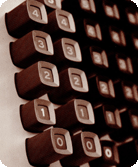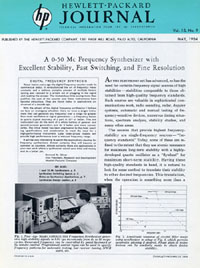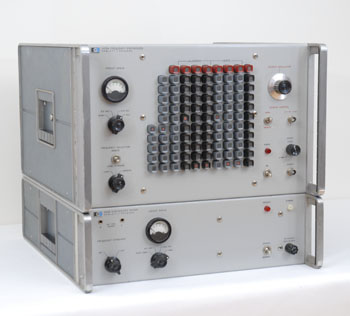 |
HP 5105A Synthesizer (top)
and HP 5110B Synthesizer Driver
|
The First Commercial Application of Frequency Synthesis
The first HP 5100A Synthesizer was introduced in the 1963 catalog. It was a DC to 50 MHz signal source providing a highly stable and pure signal derived from an internal 1 MHz quartz oscillator or from an external frequency standard. The digital frequency selection was made in increments as fine as 0.01 Hertz by front panel pushbutton or by remote switch closure.
The basic principle that conducts the 5100 development was the following: "The sources that provide the highest frequency stability are single frequency sources, commonly called "Frequency Standards." Having these high quality standards to hand, it is natural to look for some method to translate their stability to other desired frequencies. This translation when the operation is something more than a single arithmetic operation, is commonly know as frequency synthesis. Hence, a variable frequency synthesizer is an instrument that translates the frequency stability of a single frequency standard, to any one of many other possible frequencies, usually over a broad spectrum."
The 5100A was of the "Direct Synthesis" type which simply performs a series of arithmetic operations on the signal from the frequency standard to achieve the desired output frequency. The direct synthesis approach has the pronounced advantages of permitting fine resolution and fast switching (lower than 1 millisecond for any frequency change), as well as an extremely clean output signal.
On the same principle, an UHF version of the same instrument, the 5105A (shown in the photo above) would be introduced in 1967 to cover the 0.1 to 500 MHz spectrum with a 0.1 Hertz resolution.
HP's First Large Team Project
Important comments about the 5100A Synthesizer project, were made by Bill Hewlett in the introduction of his book: "Inventions of Opportunity" edited in 1983:
"The development of the synthesizer was of additional interest in that it marked a change in HP's product-development procedure. Most prior developments were basically a one-person, or at most a small-team, short-term effort. In contrast, development of the frequency synthesizer was distinctly a team effort, requiring almost 40-man-years of engineering spread over a period of about three years—a major commitment to a new technology. This effort resulted in an instrument that provided almost unheard of resolution, and had an added advantage in that it was electrically programmable—an important feature in light of the rapidly developing field of automated testing."
Complexity of the 5100A synthesizer described by Bill Hewlett, is clearly illustrated by looking inside the instrument.
| HP 5105A Synthesizer, UHF Deck swung out |
 |
| HP 5105A Synthesizer, opposite side of the UHF Deck shown above |
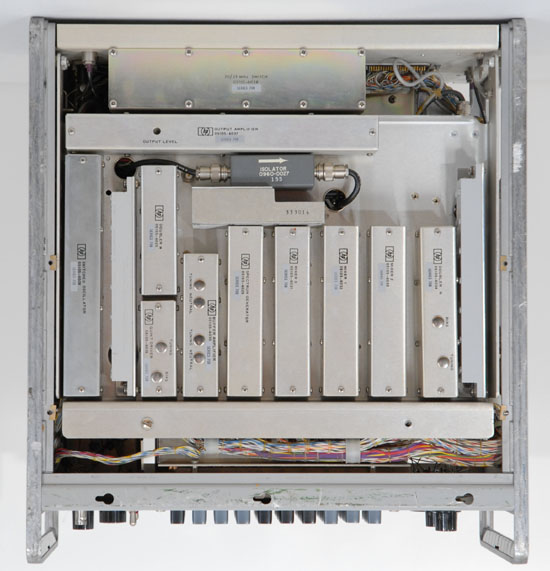 |
Main Challenge to Design Such an Instrument in 1963
Looking at the simplified block diagram, it is easy to understand the complexity of the 5100A synthesizer. It is a funny game today to consider the problems generated by the design of such an instrument by the beginning of the 1960s.
We must, first of all, keep in mind that the transistor was barely ten years old. The goal was to produce an instrument that can generate billions of discrete frequencies derivate from a single one. The direct synthesis approach used to achieve that goal only permitted the use of the four basic arithmetic operations. The discrete-components only, electronic circuits available at this time to do the job were: Frequency multiplier, Frequency Divider, and Mixer for the add and subtract operations. There was obviously no integrated logic circuitry to achieve the quantity of signal switching required. The only electronic switch of the time was the diode. Even the front panel keyboard had to be built from 103 mechanical pushbuttons switches. First matrix keyboards will only appear five years later on the 9100A calculator.
And above all, the major problem to solve was the rejection of the many intermediate signals generated inside the box, all necessary to build the final frequency, but unwanted at the output connector. For output signal to retain the same cleanliness as the standard, some rather sophisticated design techniques have been used in the system. Considerable attention has been given to shielding and termination.
| HP 5100A Synthesizer, Simplified Block Diagram |
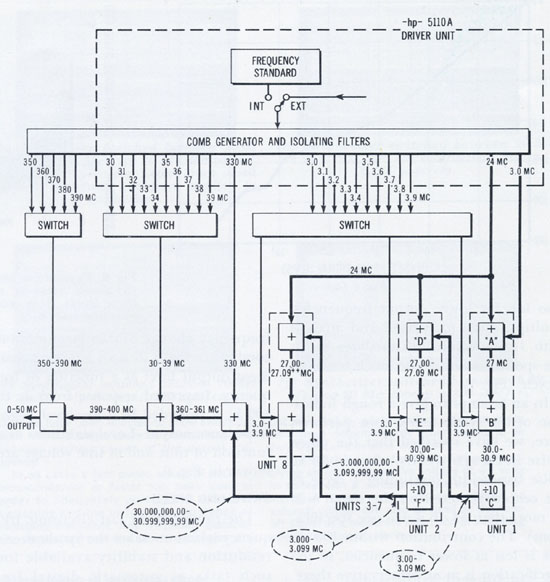 |
Final Result
The picture below is the final result displayed on a HP 70000 MMS Spectrum Analyzer. The yellow curve shows the output signal of the HP Memory Collection 5105A Synthesizer at 490 MHz. The green trace, for comparison, is the output of a 20 years younger, 8657A Synthesized Signal Generator. The high noise floor of the 5105A is mainly due to its broadband output amplifier. Building a 100 kHz to 500 MHz amplifier with transistor performance of this time was a difficult challenge.
| HP 5105A Synthesizer Output Signal @ 490 MHz |
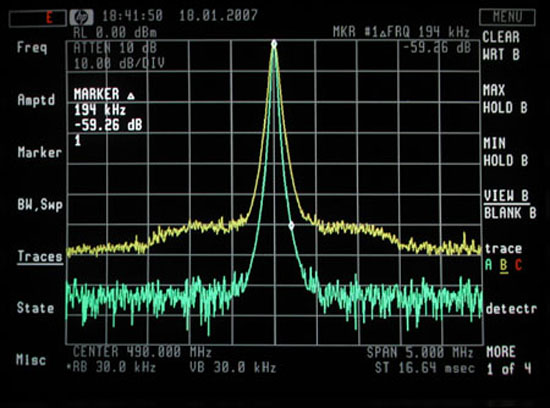 |
Barney Oliver Viewpoint about Synthesizers Future Evolution,
From the Hewlett Packard Journal, May 1964 edition
"About twelve years ago the digital frequency counter made its commercial debut. It revolutionized the art of frequency measurement; and a tedious, complex process of multiple heterodyning was reduced to a simple act of plugging in the signal and reading the answer. The tremendous time saving more than justified the cost of the counter and these instruments have become ubiquitous. They are found today in applications undreamed of a decade ago.
With the advent of the digital frequency synthesizer I believe we face an analogous situation. Here we have a single instrument that can generate any frequency over a range far greater than most oscillators or signal generators — a frequency known to quartz crystal accuracy of a part in 10E10 or better. This one instrument can do the work of a whole battery of general and special-purpose generators and do it better and more conveniently. The initial model has been engineered to the most exacting specifications and construction to meet the need for a high-performance instrument. Later lower-priced models will provide high performance over a reduced frequency range.
It will be very interesting to watch the applications develop for frequency synthesizers. Almost certainly they will become as common as counters. Almost certainly there are applications in your own work where a synthesizer would save time and money and do a better job."
Another Leap Forward in Production Testing
Thanks to the frequency synthesizer, testing frequency sensitive devices could now be done automatically, rapidly, with great precision and with a spectrally pure stimulus. As an example of one of many applications made possible by a synthesizer's remote programming capability, the plot below shows the response of a single side band crystal filter. Less than one minute was required for the complete plot.
Crystal Filter Response Plot. From Application Note Nbr 96, page 24.
Courtesy of Hewlett Packard Company |
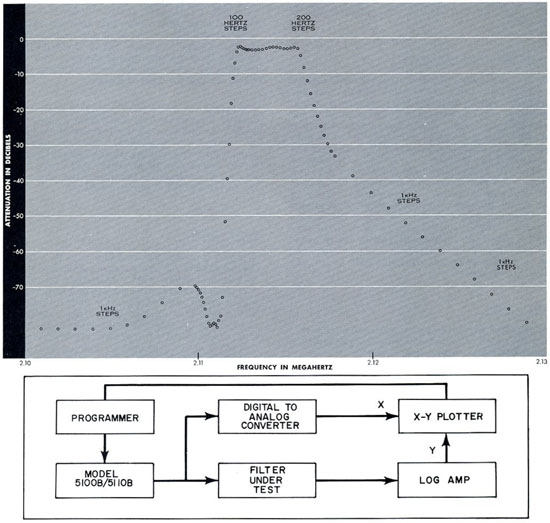 |
In-depth Understanding of the Model 5100 and 5105 Synthesizers
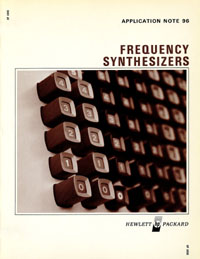 |
Cover of AN 96 - January,1969
Courtesy of the Hewlett-Packard Company
|
The AN 96
Link below gives access to a copy of the 32 pages original document.
PDF format (8.3 Mb)
Frequency Synthesizers
HP DIRECT-TYPE FREQUENCY SYNTHESIZERS, Theory, Performance and Use.


